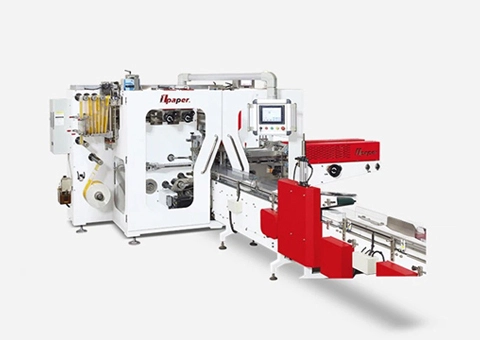
















As a leading supplier of tissue machines, ONEPAPER focuses on providing highly efficient tissue machines for your tissue production. Our facial tissue machines meet the diverse needs of tissue manufacturing. We offer a range of high-quality facial tissue machines to optimize your production process. The following are the main types of facial tissue machines we offer:
Our tissue folding machines are widely used in the process of folding facial tissues into required shapes for packaging. This facial tissue folding machine can produce various folding patterns, such as V-fold, Z-fold, and more customized packaging needs.
Our tissue cutting machine is designed for precision cutting with automatic length measurement and smooth cutting edges. It can produce perfectly sized tissues. This tissue paper cutting machine is ideal for your business in improving production accuracy and efficiency.
ONEPAPER tissue packing machine is used in the final process of tissue production. It wraps facial tissues into consumer-ready packaging, and it supports various packaging needs for shapes and sizes. This facial tissue wrapping machine can be your best choice for maximum productivity.
At ONEPAPER, whether you require a single tissue machine or a facial tissue full production line, you can find the best solution in our full range of facial tissue machines. Let ONEPAPER be your trusted partner in tissue manufacturing.
Increased Efficiency: Automatic machines can produce facial tissues at a much faster rate compared to manual or semi-automatic machines, significantly increasing production capacity.
Consistency and Quality: These facial tissue machines ensure uniformity in the size, shape, and quality of the tissues produced, reducing the likelihood of defects and maintaining high standards.
Scalability: Automatic machines can be easily scaled up to meet increasing demand, making it easier for manufacturers to expand their operations.Customization: Automatic machines can be programmed to produce a variety of tissue types and sizes, offering flexibility to meet different market demands.
Flexibility: Machines can be adjusted to produce various types of tissues, such as facial tissues, toilet paper, and paper towels, catering to different market demands.
Customization: Allows for the production of tissues with different textures, patterns, and ply counts to meet specific consumer preferences.
Facial tissue paper making machines are playing a pivotal role in transforming the paper industry, marking a significant leap towards innovation and efficiency. These face tissue making machines, equipped with cutting-edge technology, have streamlined the production process, enabling paper making machine manufacturers to produce high-quality facial tissues at an unprecedented pace. The integration of automation within these machines minimizes human error, ensuring consistency in quality and texture of the final product, which is essential for meeting consumer expectations in the personal care market.
Moreover, modern automatic facial tissue machines are designed with sustainability in mind. They are capable of processing recycled paper materials, reducing the industry's carbon footprint and promoting eco-friendly production practices. This not only helps manufacturers adhere to environmental regulations but also caters to the growing consumer demand for sustainable products.
Additionally, the versatility of these facial tissue paper making machines allows for the production of tissues that cater to a variety of market needs, from ultra-soft tissues for sensitive skin to more durable options for general use. By significantly reducing production time and costs, tissue paper manufacturing machines are not just revolutionizing the paper industry; they are setting new standards for quality, efficiency, and environmental responsibility.
The science behind tissue manufacturing machine is a fascinating blend of mechanical engineering and material science, aimed at enhancing both the softness and strength of facial tissues. At the core of this process is the careful selection and treatment of raw materials, typically made from a mix of softwood and hardwood pulps. The softwood pulp provides the necessary strength due to its long fibers, while the hardwood pulp, with its shorter fibers, contributes to the softness of the tissue.
Advanced tissue paper maker machines utilize a process known as Through-Air-Drying (TAD) technology, which significantly improves the tissue’s softness by removing water from the wet web of paper using hot air. This method not only enhances the softness but also the bulk and absorbency of the tissue without compromising its strength. Additionally, the creping process, where the paper is scraped off a cylinder, creates a micro-folding in the tissue, further increasing its softness and flexibility.
Moreover, these facial tissue paper manufacturing machines are equipped with precise control systems that monitor and adjust the production parameters in real-time, ensuring the optimal blend of softness and strength in the final product. Through the integration of these advanced technologies, tissue paper machines are setting new benchmarks in the production of high-quality tissues, meeting the consumers’ growing expectations for products that are both gentle on the skin and durable.
The main functions include paper cutting, folding, stacking, counting, packaging and labeling.
In addition to the important role they play in makeup and beauty routines, facial tissues are an essential item in any office environment. Their soft, absorbent nature also makes them ideal for protecting fragile items. Whether you're organizing your workspace, dealing with minor accidents, or ensuring your valuables are safely protected, facial tissues are a versatile item.
An automatic facial tissue machine is a device used to produce facial tissue, which can automatically complete the processes of cutting, folding, stacking and packaging of paper.
A tissue manufacturing machine works by processing raw paper pulp into finished tissue products. The process begins with the preparation of the pulp, which is diluted with water and refined to achieve the desired consistency. The pulp is then spread onto a moving wire mesh, where water is drained, forming a continuous sheet. This sheet is pressed and dried using heated rollers to remove remaining moisture. The dried paper is then creped, giving it softness and flexibility. Finally, the tissue is wound onto large rolls, cut to size, and packaged. Automation ensures precision, efficiency, and consistent quality throughout the process.



